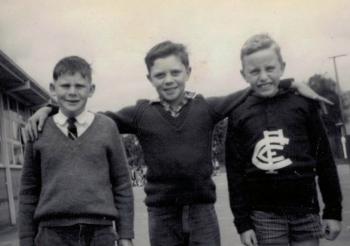Boonong Boy

Little dots of white on each ripple
Dark in the hollows
Shades and shallows
Painting the wind
Is this what happens when you become old and grey?
Seeing, at last, with a painters eye.
Maxim Gorky’s My Childhood is the memorable accout of the searing poverty that led to the 1917 Russian Revolution. Marcel Proust’s Remembrance of Things Past is the broken, slumbering memories of an old man. A.B. Facey’s A Fortunate LIfe is the spare memoir of pre-WW1 white rural Australia, Shaun Carney’s Press Escape is a haunting allegory of Melbourne’s outer suburbs. It is a story of childhood in the 1960s, adolescence in the 1970s, adulthood in the 1980s, middle age in the 1990s, maturity in the 2000s - and the weary journey from the outer suburbs of the ‘worlds most liveable city’ to life and the world. Carney has written millions of words for the grand, Melbourne Herald, then The Age and now the Herald Sun and has a beautiful understated style. At his best, like so many others, Alan Ramsey comes to mind, he has taken ‘voluntary redundancy’ and is no longer writing full time for the train wrecks we call newspapers in the age of online opinion. But his story is about much more than that. In between the lines is an allegory about death, deception, lies, fear and living. I think a growing readership will warm to this book. Shaun found his way to writing by imagining that he was writing for his father - a welder and small business man, who would scan the by-lines in his lounge chair with smokers table nearby, in a house that stayed with Shaun most of his life and was a replica of one hundred thousand others in suburban Australia. When his father died Shaun lost his enthusiasm for writing. But it was also the end of the newspaper as an institution which could pay for a salaried workforce tuned to the standards of pay that had been established by Justice Higgins in the early 20th century. In this sense newspaper writers, opinion-makers and illustrators encountered what the rest of the Australian workforce had been dealing with since the 1970s. But there is still so much change to come for this land which creates terrible barriers against the rest of the world that lives on so much less than the average Australian wage. We preserve our own enclave and most of us have no idea of the foundations the whole facade is built upon. This is perhaps the real ugliness of Pauline Hanson and her thousands of followers. It is an ignorance that is now less about racism than it is about our own privileged white and now multi-cultural life. This is also why the non-recognition of Indigenous land and value is so hypocritical. Unless we do this we are nothing less than the equivalent of privileged nobles in another world. The time for our own accountability will surely come. In this context what is so important about Press Escape is that it allows us to think about the values that gave suburban boys and girls of my era such an amazing run at life. We have to ask ourselves: how did this cosmos come about? My review of Press Escape is necessarily personal for I was one of the boys, yes boys, running around the Boonong Ave precinct where he grew up in the 1960s. Of course there were girls that were very important to us, but as I get older, I see that Shaun’s and my own recollections are very much boys own stories. There are always however in every boy’s story, powerful women, often in the shadows, and in Shaun’s story the strength of his Mum is there through everything. I see her influence in the picture above of these immacuately presented boys, fawned over with a moist cloth and brush, well fitted with warm clothes for the Melbourne winter, clean, healthy, shining. And there, in the centre, Shaun waiting too, to fly to where-ever life might lead him.


